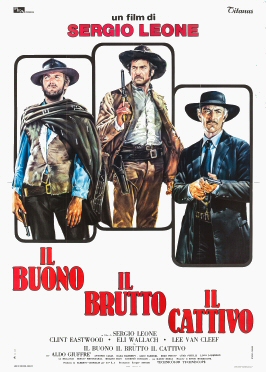Clint Eastwood's Man With No Name* may be the movies' most famous picaro, the roguish hero who wanders through an often hostile landscape, surviving by his wits -- and in this case, his skill as a gunman. The picaro's heart is generally in the right place even if he doesn't mind breaking a few laws to get his way. In the first two films of Sergio Leone's "Dollars Trilogy," A Fistful of Dollars (1964) and For a Few Dollars More (1965), he is a loner, but in The Good, the Bad and the Ugly he has picked up an unlikely (and untrustworthy) sidekick in Tuco (Eli Wallach), with whom he is working a scam: Tuco has a price on his head, which our hero collects by bringing Tuco in to justice, and then splits with Tuco after rescuing him from a hanging. Tuco is a more vicious Sancho Panza to No Name's more capable Don Quixote. I think it's interesting that The Good.... was filmed in Spain, where the picaresque tradition began with Lazarillo de Tormes in 1557 and produced its most influential analog in Don Quixote. Okay, I'm getting a little pretentious with the literary history here -- though Leone himself once admitted his debt to the picaresque tradition. But who, in the mid-1960s, when Leone was making movies derided as "spaghetti Westerns," would have anticipated such analysis or the veneration those films receive today? Half a century ago, when Leone's trilogy was being released, critics were raving about films like A Man for All Seasons (Fred Zinnemann, 1966), Doctor Zhivago (David Lean, 1965), and Becket (Peter Glenville, 1964): "prestige" movies on high-toned subjects that have dated badly, while Leone's movies still get enthusiastic viewings. The Good, the Bad and the Ugly currently has an 8.9 rating on IMDb and a 97 percent favorable on Rotten Tomatoes -- the only two negative reviews cited on the latter are the ones from Time and Variety at the time of the film's release. My own view is that The Good.... is overlong, especially in its latest restoration, which runs for 177 minutes, and that there's some confusion in integrating the Civil War's New Mexico Campaign scenes with the story of the titular triad. But there are few scenes in movies more dazzling than Tuco's dash through the cemetery and the subsequent three-way standoff. Lee Van Cleef is a suitably scary Bad guy; Eastwood demonstrates the growth as an actor that would continue as his career soared; Wallach gives one of his best performances: and the contribution of Ennio Morricone is breathtaking. Raw and unpolished as The Good, the Bad and the Ugly at times is, it remains memorable filmmaking, while the films more celebrated in its day are mostly forgettable.
*Actually, he picks up a name in each of Leone's "Dollars Trilogy" films: In A Fistful of Dollars he is called "Joe," which is a generic name for an americano. In For a Few Dollars More he is known as Monco, the Italian word for "one-armed," in reference to his tendency to use his left hand while keeping his gun hand under his poncho. And in the third film he is dubbed "Blondie" by Tuco. (The color of Eastwood's hair seems to me like a minor characteristic, but I guess "Tall Guy Who Squints and Smokes Cheroots" would have been a mouthful.)
A blog formerly known as Bookishness / By Charles Matthews
"Dazzled by so many and such marvelous inventions, the people of Macondo ... became indignant over the living images that the prosperous merchant Bruno Crespi projected in the theater with the lion-head ticket windows, for a character who had died and was buried in one film and for whose misfortune tears had been shed would reappear alive and transformed into an Arab in the next one. The audience, who had paid two cents apiece to share the difficulties of the actors, would not tolerate that outlandish fraud and they broke up the seats. The mayor, at the urging of Bruno Crespi, explained in a proclamation that the cinema was a machine of illusions that did not merit the emotional outbursts of the audience. With that discouraging explanation many ... decided not to return to the movies, considering that they already had too many troubles of their own to weep over the acted-out misfortunes of imaginary beings."--Gabriel García Márquez, One Hundred Years of Solitude
